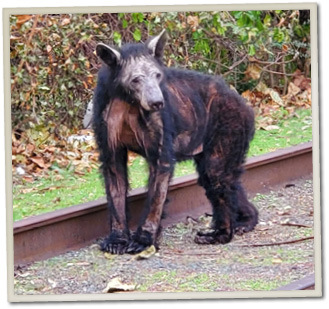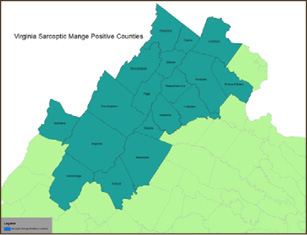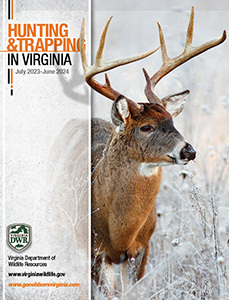Black Bears with Mange
Sarcoptic mange is a highly contagious skin disease of mammals caused by mites. It is the most common agent isolated in severely affected black bears. S. scabiiei has a wide host range that includes dogs, foxes, coyotes, horses, cows, cats, and numerous other domestic and wildlife species. Humans are susceptible to S. scabiiei infestation but most infections are mild and do not require treatment.
Hunters should carefully evaluate bears before harvest and refrain from harvesting bears that show any signs of mange. Determining if a bear has mange can be difficult in the field, especially because other conditions can appear similar to mange, such as normal shedding. The DWR mange brochure (URL at the bottom of this document) contains photos of bears with mange along with additional characteristics to look for to help in your assessment. Research and experience in other states show that many bears with mild to moderate cases can survive and clear symptoms of mange. If you have any doubts, please refrain from harvesting the bear; instead, take photos, note your exact location (take GPS coordinates, if possible) and submit this information to the Virginia Wildlife Conflict Helpline at [email protected] or (1-855-571-9003).
Bear Training Seasons
- A mange-infested bear cannot be killed during any bear training (chase) seasons. Hunters should report any mange-suspect bear observed while training to the Virginia Wildlife Conflict Helpline as soon as possible (with photos and location coordinates): [email protected] or (1-855-571-9003)
Harvesting a Mange-Infested Bear
- If a hunter harvests a bear with signs of mange during an open bear season (regardless of condition/degree of infestation), they must utilize their bear tag and report the bear at the time of harvest. Reporting the harvest of a bear (including those with mange) is both required by law and is a vital element of the Department’s bear management program.
- Because humans can contract mange, handling of the bear carcass isn’t required, and the bear does not need to be removed from the place of harvest.
- A photo of the bear (at the time of harvest) along with GPS coordinates or specific location should be collected. Photos should include potential evidence of mange (lack of hair, crusting skin, etc.) so that staff can evaluate the animal effectively and efficiently.
- IMPORTANT: The harvested bear should be reported to [email protected] with the photo and confirmation number from reporting the harvest. DWR will evaluate the submission and contact the hunter regarding license status or to collect additional information on the harvested bear’s condition. If DWR can confirm that the bear had mange, the hunter will be eligible for a replacement bear tag, if they so desire. If you do not have access to email, you may call the Virginia Wildlife Conflict Helpline as soon as possible (1-855-571-9003), however there may be some delays when reporting by phone.
Best Management Practices for Possible Exposure to a Mange-Infested Bear
- Handling of a mange-infested bear should be minimized to avoid unnecessary exposure. Hunters should take precautions if handling and/or disposing of the pelt and carcass. These precautions include wearing disposable gloves, using a Permethrin-based insect repellant on clothes/gear (as instructed by the label), bagging gloves and any other disposable equipment after use, and disposing of them in a dumpster or similar location. Hands and arms should be washed thoroughly with soap. Contaminated clothing should be washed and machine-dried with heat or placed in a freezer overnight to kill any mites. If the carcass of a bear with signs of mange is removed from the harvest site, the hunter should try to dispose of the pelt by double-bagging or returning it to the site of harvest.
- Hunters should contact their veterinarian to discuss options for their hounds that may have come into contact with a mange-infested bear or an area occupied by a mange-infested bear (e.g., den, bedding site, etc.).
- Equipment (dog leashes, dog box, etc.) should be disinfected (e.g., 40% bleach solution or other disinfectant cleaner for equipment and clothing) if suspected of being in contact with a mange-infested bear or with a dog that has come into contact with a mange-infested bear.
- Contact your health care provider for more information related to a potential exposure to mange.
Important Information about Mange in Bears (including images)
virginiawildlife.gov/wildlife/information/black-bear/#section-mange-and-black-bears
virginiawildlife.gov/wp-content/uploads/media/Black-Bear-Mange-Brochure.pdf



